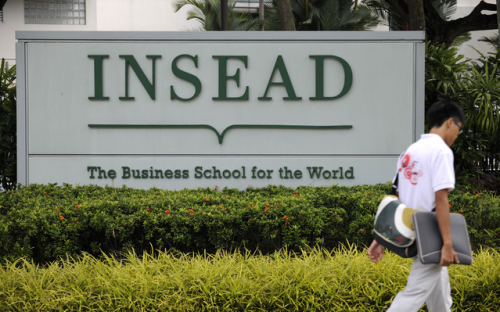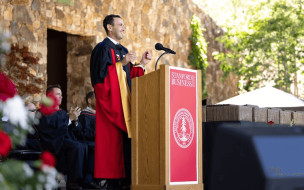INSEAD trounced all competition in the Financial Times’ MBA ranking this week — a further sign of the growing prestige of European institutions. INSEAD, of Fontainebleau, France and Singapore, is ranked No. 1 for the second consecutive year.
There were gains across Europe. Judge Business School at Cambridge University of the UK is ranked No. 5 for the first time. IE Business School of Spain is up three places in No. 8. And IESE Business School, also Spanish, rose to No. 10.
Meanwhile, US business schools continued to lose ground at the very top. Harvard Business School failed to make the top-three for the first time in nine years. MIT Sloan School of Management did not even stay in the top-10, a decade first. Columbia Business School and Chicago’s Booth School of Business also nursed losses.
Rankings are important because MBA candidates often evaluate schools on how prestigious they are perceived to be.
It was not all rosy for Europe, with London Business School falling to No. 6, but Dan Bauer, CEO of admissions consultancy The MBA Exchange, believes there is an end in sight to the historic dominance by US schools.
The US now accounts for five of the world’s top-10 business schools. When the FT introduced the ranking in 1999, only one non-US university, LBS, made it into the top tier.
What has prompted the change in Europe’s fortunes? One clue is the growing appeal of one-year degree programs.
The FT ranks business schools partly on career progression. Cambridge Judge’s MBAs are paid $164,741 on average three years after graduation, on a par with its competitors. But the shorter duration of the program (12 months) and lower tuition fees (£51,000) mean Cambridge Judge is ranked top for value for money.
“People are putting a lot of financial resources into an MBA,” says Conrad Chua, head of MBA admissions and careers at Cambridge Judge. “The opportunity cost of leaving employment is something students must also consider.” When adding living expenses, and the cost of leaving a job to study full-time, the bill for a two-year degree in the US exceeds $300,000.
Cambridge Judge’s and INSEAD’s success is likely to fuel further the popularity of one year MBAs. The format’s lustre is cemented by the fact that several top US schools are adopting it, including Cornell’s SC Johnson College of Business and Northwestern’s Kellogg School of Management.
“It will continue to prompt the rise of European schools that have one-year programs,” says The MBA Exchange’s Dan.
US schools say the two-year MBA has not yet had its day. Rod Garcia, senior director of MBA admissions, MIT Sloan, says: “The MIT brand is far more important to the applicants than the length of the program. Given a choice between attending a top one-year program or two-year MIT Sloan MBA program, there is no doubt that the majority would choose to attend the two-year program.”
Stanford’s Graduate School of Business and The Wharton School enjoyed continued success in this year’s rankings.
The rise of European schools however, cannot be ignored. A key factor driving their success is international culture, which INSEAD has built up across multinational campuses, along with one of the most extensive and diverse alumni networks.
Urs Peyer, INSEAD dean of degree programs, says: “Bringing together talented people from all over the world creates a unique learning and networking environment. It is inspiring to see that the success of our alumni…Led to this outstanding result.”
The European business schools that have performed best are those that are diverse, international and open. The FT ranks MBA programs according to career progression, but also research and diversity.
Yet Cambridge Judge, whose success relies heavily on a 90% international MBA cohort, is vulnerable to the challenges created by Brexit. Potential windfalls include the need to secure visas for students and faculty, and the potential weakening of career prospects for foreign graduates.
“The expectation of higher tuition and visa constraints is likely to discourage future applicants from pursuing UK-based institutions such as LBS, Cambridge Judge and the Saïd Business School at Oxford University,” says The MBA Exchange’s Dan.
“However,” he adds, “This scenario will create growth opportunities for top European schools outside the UK, especially MBA programs in Spain, France and Italy.”
One such school is IESE of Barcelona. “We have already seen a few students turned off by uncertainty. IESE is well positioned to attract those top students,” says Marc Badia, academic director of the first-year MBA program.
Spanish schools fared well in the FT’s ranking. Martin Boehm, the dean of IE Business School, puts this down to the nation’s improving economic conditions.
“Salaries are rising again and the unemployment rate is going down,” he says. “Spain is becoming an even more attractive MBA market.” IE MBAs’ salaries are up by about $8,000 to around $169,000.
Meanwhile, several programs in Asia are climbing the rankings, led by Shanghai’s China Europe International Business School, giving applicants from that continent more reasons to stay closer to home and away from the US.
As the rankings landscape changes, the days of American dominance may be numbered.
RECAPTHA :
e4
7e
7c
4a







